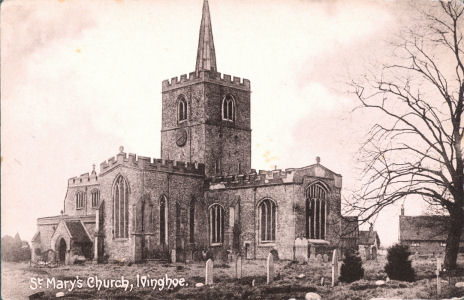|
|
Ivinghoe, Buckinghamshire Under construction |
|
||||||||||||||
|
Please Note - This page contains links and pictures to augment the Genealogy in Hertfordshire Web Site. There are no plans to extend the "Ask Chris" facility to cover queries relating to Ivinghoe. |
External Links Historic Town Assessment Report
|
|||||||||||||||
Ivinghoe (Tring, Herts, 3 m.) is a place of the past. Three short streets radiate from the church, forming now a fair-sized village; at one time it was a small town, with its market, fair, and Court house (now a parish room), and with some considerable houses near and around it, which have since disappeared. It is easy to understand its greater Importance in the past. It stands just on the edge of the Chilterns on the verge of the meadows, and within it were collected those who in summer pastured their cattle on the meadows which extended far to the north. Placed, too, at the junction of the Upper and Lower Icknield Ways, and on the road for wayfarers passing to the N. W., up the gap in the Chilterns which lies to the E. of Tring, it had a situation which tended to make it of some importance. Now it is left stranded by the movement of time. The only interesting feature in the place is the fine cruciform church. The Manor of Ivinghoe was granted by Edward the Confessor to the See of Winchester, and in the possession of the Bishops of Winchester it remained till 1551. This fact, together with the comparative importance of the little town, will help us to understand how so large and admirable a church was placed here, a miniature cathedral in design, with its nave, chancel, N. and S. transepts and central tower, from which rises a small steeple. The central tower, supported in the interior by four sets of clustered columns, gives the church within a grandeur which is striking. The church, though built c. 1230, is now mostly Dec., with some good windows of that period on the N. and S. side of nave, but the E. window is P . Note the fine wooden roofs (15th century) ornamented with carved figures of angels, monks, panels, bosses, etc., and the fine W. porch. On the N. side of chancel is a monument under a 15th-century recess. The figure of a priest. There is not sufficient evidence of the identity of the figure represented to enable it to be stated whom it depicts, though needless to say very definite statements have hitherto been made on the point. The well-preserved carving on the capitals of the pillars, the quaint and rude carving (15th century) on the standards of the modern benches, the early 17th century pulpit, with the large and no doubt much appreciated hour-glass stand, should not be overlooked. Within the altar rails are several brasses, much worn. It is not quite certain that the inscriptions are rightly allotted to the effigies. On the S. side of floor are the effigies of Richard Blackhed, 1517, and his wife, Maude, and above them one to William Duncombe, 1576. The effigies of his wives and children are lost. On the N. side are two more brasses, one commemorating Thos. Duncombe, 1531, and the other John Duncombe, 1594. To each of these the effigy of the wife is lost. Sir Walter Scott took the title of his novel, as well as of its hero, from the name of the village of Ivinghoe. "The name of Ivanhoe," he says in his Introduction, "was suggested by an old rhyme. All novelists have had occasion at some time or other to wish, with Falstalf, that they knew where a commodity of good names was to be had. On such an occasion the author chanced to call to memory a rhyme recording three names of the manors forfeited by the ancestor of the celebrated Hampden for striking the Black Prince a blow with his racket when they quarrelled at tennis :- "Tring, Wing and Ivanhoe, For striking of a blow, Hampden did forego, And glad he could escape so."
It is somewhat curious to note that Scott apparently had forgotten the true name of the place, as he quotes it incorrectly. The tradition, too, on which the rhyme was founded, has been disproved, as the Hampdens were never in possession of these manors, and the lines have recently been considered as a remnant of a cavalier song. Buckinghamshire (Little Guide), 1918 |
||||||||||||||||
|
Linked Pages
|
||||||||||||||||
|
||||||||||||||||


